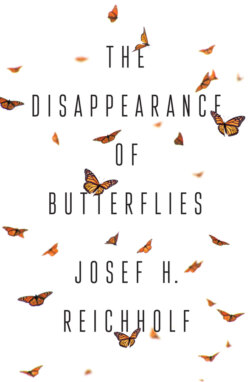Читать книгу The Disappearance of Butterflies - Josef H. Reichholf - Страница 5
Foreword
ОглавлениеMost people in the British Isles and North America – as well as on the European mainland – are by now well aware that many species of wildlife are declining and even disappearing. Butterflies and moths (Lepidoptera) are prominent among them. The author of this authoritative book, Dr Josef Reichholf, became concerned about the decline of many species in his native Germany during his doctoral and postdoctoral research at the Ludwig-Maximilian University of Munich on moths in both rural and urban areas around that city in the 1970s and 1980s. He became aware of the staggering speed of change and its extent, mainly due to the intensification of agriculture. The subject of his doctoral research was a group of aquatic moths belonging to the Crambid family, which he studied intensively in the field at a cluster of gravel pits near his boyhood home in Bavaria. Some time after completing his thesis, Dr Reichholf was saddened to find that some of these pits had been converted to swimming pools and others infilled and returned to agriculture, mostly for the cultivation of maize. At the same time, the riparian woodlands along the River Inn, which had been a favourite wildlife haunt of his – he started out as a bird-watcher in 1958 – were being uprooted to make way for the booming and profitable cultivation of maize. With the maize monoculture came the intensive use of pesticides to control the pests that infect it.
Dr Reichholf eventually made a long-term study of the Lepidoptera in urban and suburban Munich, mainly by employing light traps, and he came to the conclusion that, although the species diversity is less in urban areas, they are doing much better in the ‘nature-friendly’ cities than they are in the ‘inhospitable’ countryside, because the former are islands of warmth (the ‘heat island’ effect) and there is a much lower use of pesticides there. He devotes the second half of the book to a critical examination of the causes of the declines in so many butterfly and moth species: these, mostly familiar to British and North American nature conservationists, include the replacement of old, traditional farming by intensive agriculture, overuse of fertilizers and pesticides poisoning the soil, deforestation and reforestation with monocultures, habitat loss, over-tidiness, light pollution and the underlying effects of climate change.
Dr Reichholf holds strong views and is outspoken in his criticism of the role of politicians and government policies with regard to the environment and its wildlife. Some nature conservationists also come in for criticism for concentrating on legally protecting species from field naturalists and collectors and for not fully recognizing that their real enemy is industrialized agriculture. Finally, he considers the consequences of the disappearance of butterflies and moths and what can be done to arrest it.
This passionate, powerful and thought-provoking book could not be more timely. It deserves to be widely read by everyone concerned about the natural environment and I am very pleased to be able to recommend it.
John F. Burton, FZS, FRES
A Vice-President of Butterfly Conservation
